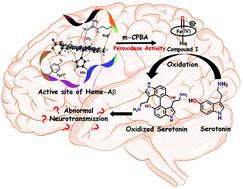当前位置:
X-MOL 学术
›
Chem. Commun.
›
论文详情
Our official English website, www.x-mol.net, welcomes your feedback! (Note: you will need to create a separate account there.)
Peroxidase activity of heme bound amyloid β peptides associated with Alzheimer's disease.
Chemical Communications ( IF 4.9 ) Pub Date : 2020-04-16 , DOI: 10.1039/c9cc09758a Madhuparna Roy 1 , Ishita Pal , Arnab Kumar Nath , Somdatta Ghosh Dey
Chemical Communications ( IF 4.9 ) Pub Date : 2020-04-16 , DOI: 10.1039/c9cc09758a Madhuparna Roy 1 , Ishita Pal , Arnab Kumar Nath , Somdatta Ghosh Dey
Affiliation

|
The amyloid cascade hypothesis attributes the neurodegeneration observed in Alzheimer's disease (AD) to the deposition of the amyloid β (Aβ) peptide into plaques and fibrils in the AD brain. The metal ion hypothesis which implicates several metal ions, viz. Zn2+, Cu2+ and Fe3+, in the AD pathology on account of their abnormal accumulation in the Aβ plaques along with an overall dyshomeostasis of these metals in the AD brain was proposed a while back. Metal ion chelators and ionophores, put forward as possible drug candidates for AD, are yet to succeed in clinical trials. Heme, which is widely distributed in the mammalian body as the prosthetic group of several important proteins and enzymes, has been thought to be associated with AD by virtue of its colocalization in the Aβ plaques along with the similarity of several heme deficiency symptoms with those of AD and most importantly, due to its ability to bind Aβ. This feature article illustrates the active site environment of heme-Aβ which resembles those of peroxidases. It also discusses the peroxidase activity of heme-Aβ, its ability to effect oxidative degradation of neurotransmitters like serotonin and also the identification of the highly reactive high-valent intermediate, compound I. The effect of second sphere residues on the formation and peroxidase activity of heme-Aβ along with the generation and decay of compound I is highlighted throughout the article. The reactivities of heme bound Aβ peptides give an alternative theory to understand the possible cause of this disease.
中文翻译:

与阿尔茨海默氏病有关的血红素结合淀粉样β肽的过氧化物酶活性。
淀粉样蛋白级联假说将在阿尔茨海默氏病(AD)中观察到的神经变性归因于淀粉样蛋白β(Aβ)肽沉积到AD脑中的斑块和原纤维中。涉及多个金属离子的金属离子假设,即。早在几年前,人们就提出了AD病理中的Zn2 +,Cu2 +和Fe3 +,因为它们在Aβ斑块中异常蓄积以及这些金属在AD脑中的总体动态平衡。金属离子螯合剂和离子载体被认为是AD的候选药物,但尚未在临床试验中获得成功。血红素作为几种重要蛋白质和酶的辅基,广泛分布于哺乳动物体内,由于其在Aβ斑块中的共定位以及几种血红素缺乏症状与AD的相似性,最重要的是由于其结合Aβ的能力,人们认为其与AD有关。该专题文章阐述了血红素-Aβ的活性位点环境,类似于过氧化物酶。它还讨论了血红素Aβ的过氧化物酶活性,其影响神经递质(如血清素)氧化降解的能力,以及高反应性高价中间体化合物I的鉴定。第二个球形残基对Ame的形成和过氧化物酶活性的影响。整篇文章重点介绍了血红素-Aβ以及化合物I的生成和衰变。血红素结合的Aβ肽的反应性提供了另一种理论来理解这种疾病的可能原因。
更新日期:2020-04-24
中文翻译:

与阿尔茨海默氏病有关的血红素结合淀粉样β肽的过氧化物酶活性。
淀粉样蛋白级联假说将在阿尔茨海默氏病(AD)中观察到的神经变性归因于淀粉样蛋白β(Aβ)肽沉积到AD脑中的斑块和原纤维中。涉及多个金属离子的金属离子假设,即。早在几年前,人们就提出了AD病理中的Zn2 +,Cu2 +和Fe3 +,因为它们在Aβ斑块中异常蓄积以及这些金属在AD脑中的总体动态平衡。金属离子螯合剂和离子载体被认为是AD的候选药物,但尚未在临床试验中获得成功。血红素作为几种重要蛋白质和酶的辅基,广泛分布于哺乳动物体内,由于其在Aβ斑块中的共定位以及几种血红素缺乏症状与AD的相似性,最重要的是由于其结合Aβ的能力,人们认为其与AD有关。该专题文章阐述了血红素-Aβ的活性位点环境,类似于过氧化物酶。它还讨论了血红素Aβ的过氧化物酶活性,其影响神经递质(如血清素)氧化降解的能力,以及高反应性高价中间体化合物I的鉴定。第二个球形残基对Ame的形成和过氧化物酶活性的影响。整篇文章重点介绍了血红素-Aβ以及化合物I的生成和衰变。血红素结合的Aβ肽的反应性提供了另一种理论来理解这种疾病的可能原因。


























 京公网安备 11010802027423号
京公网安备 11010802027423号